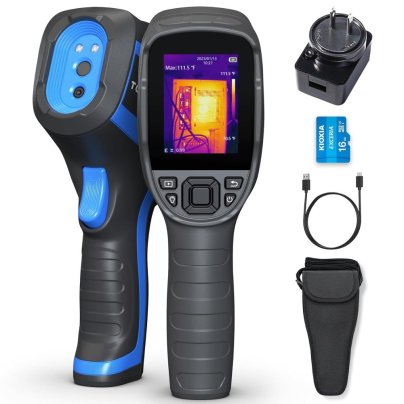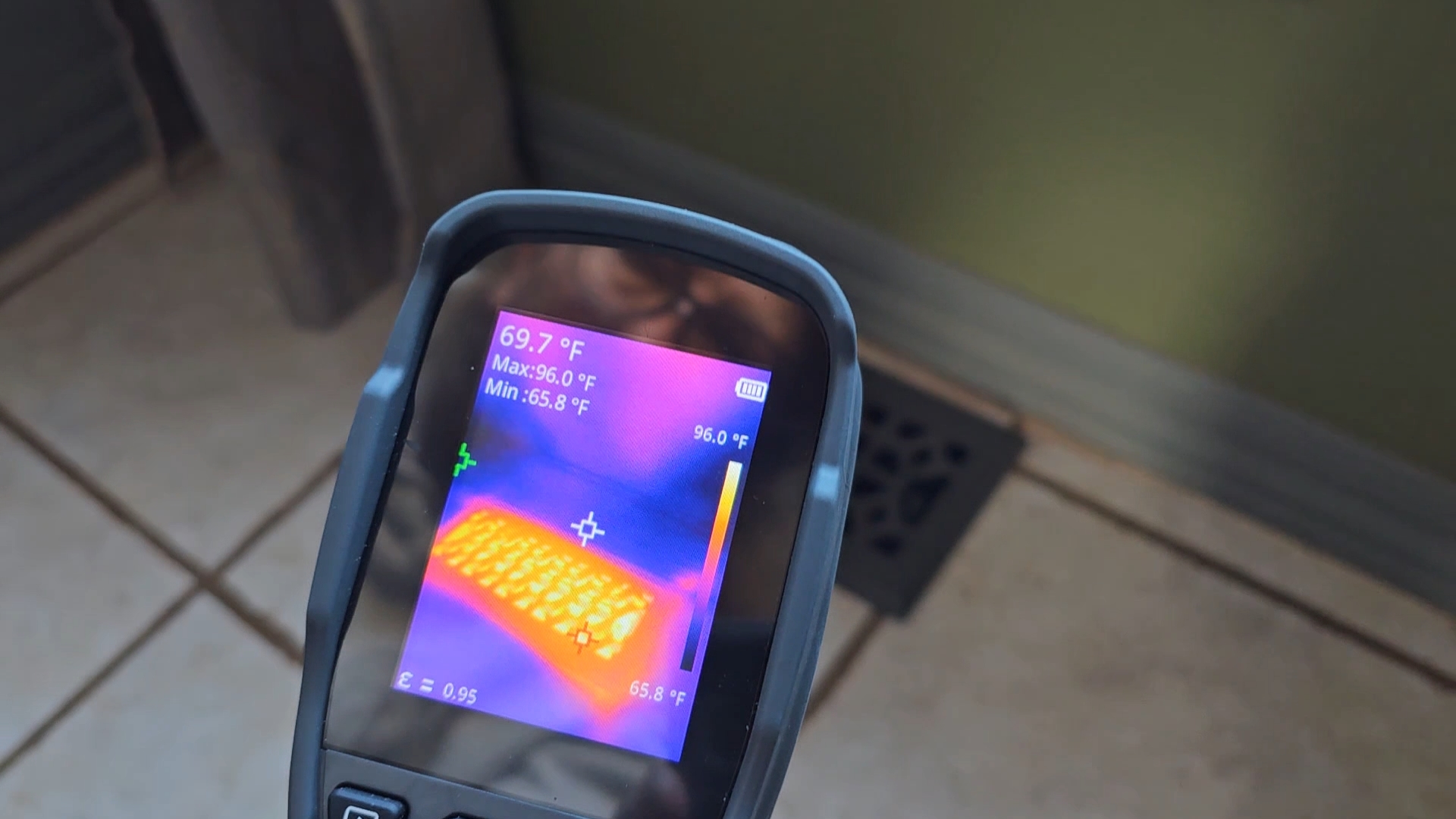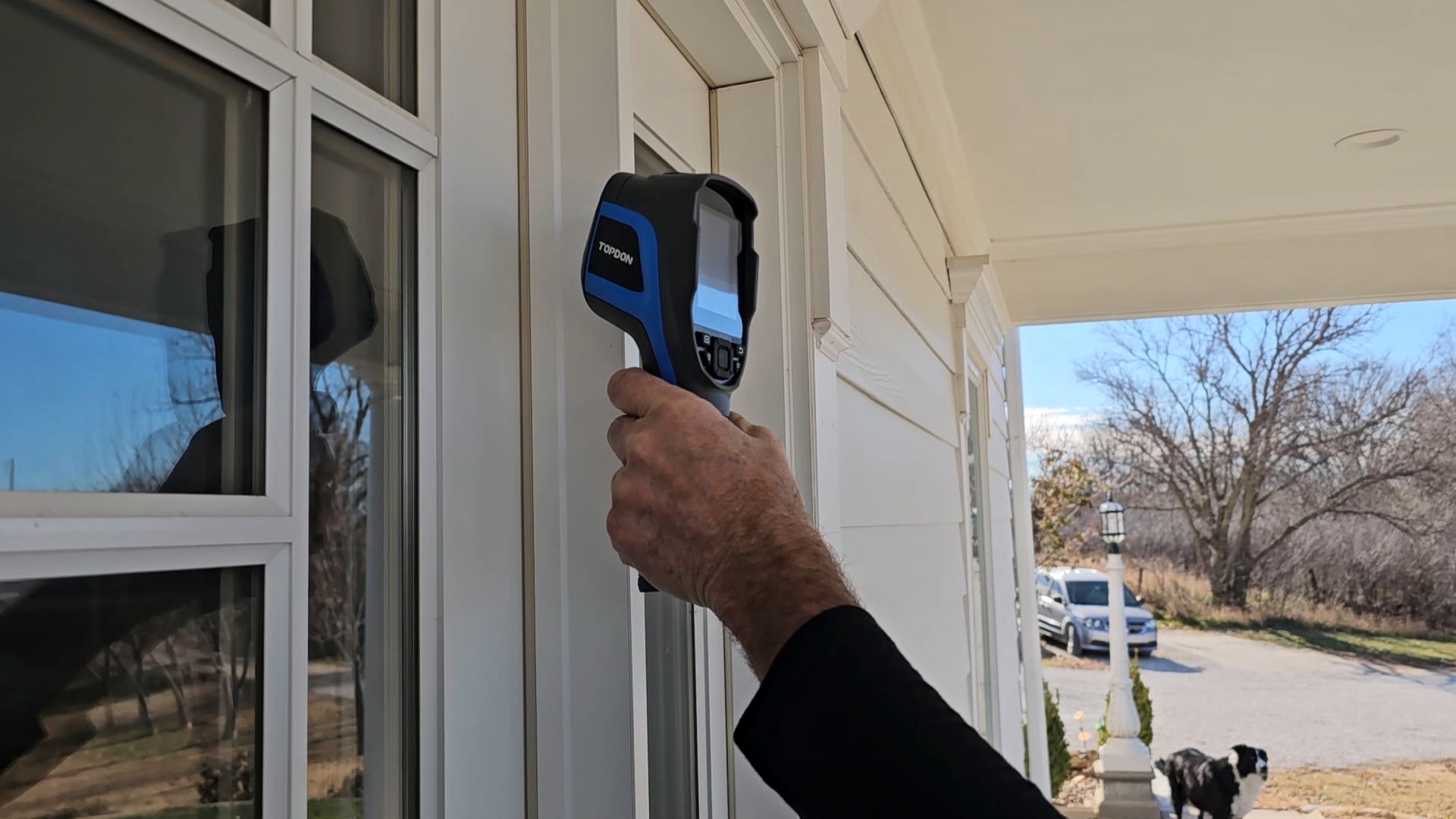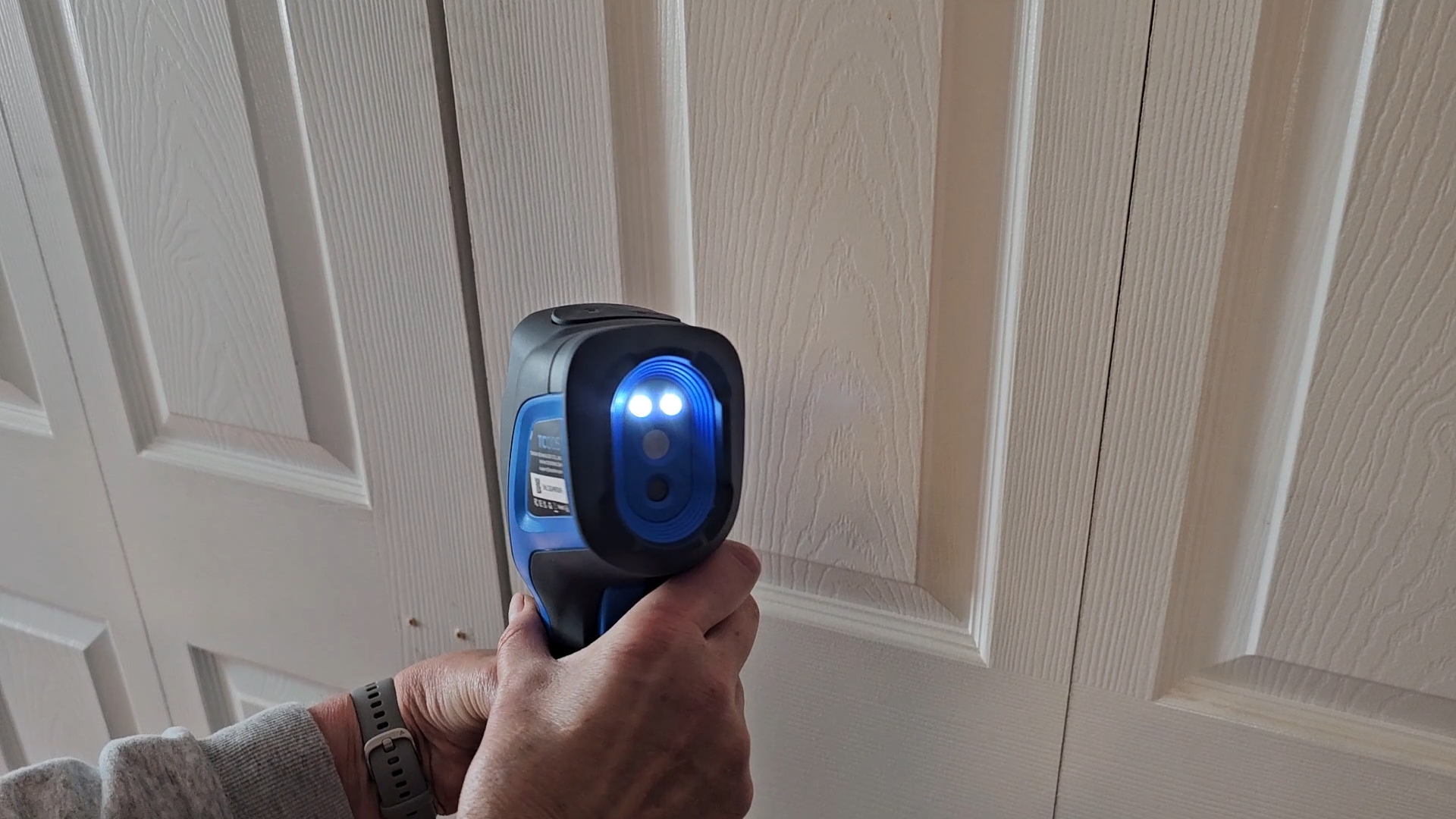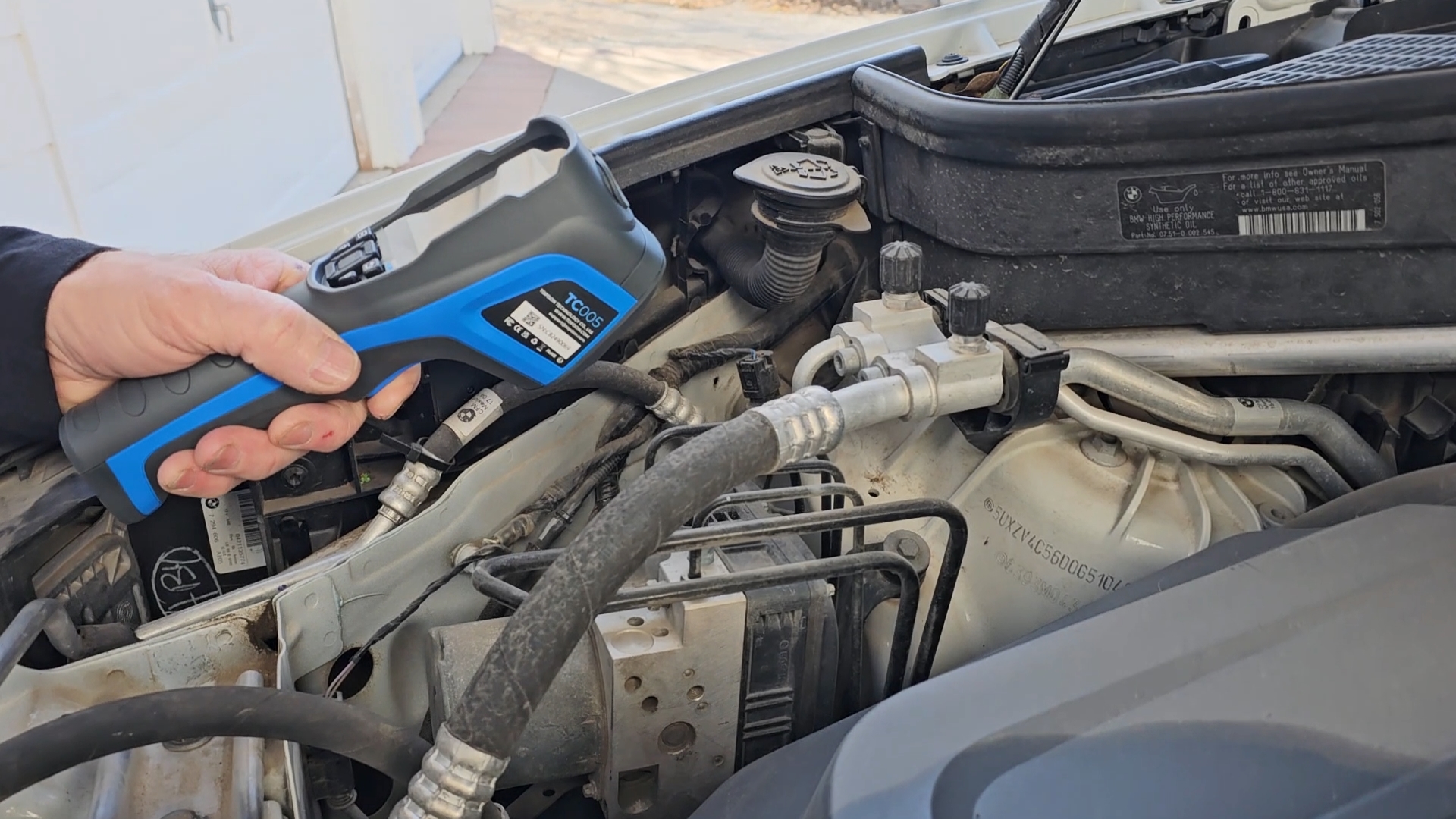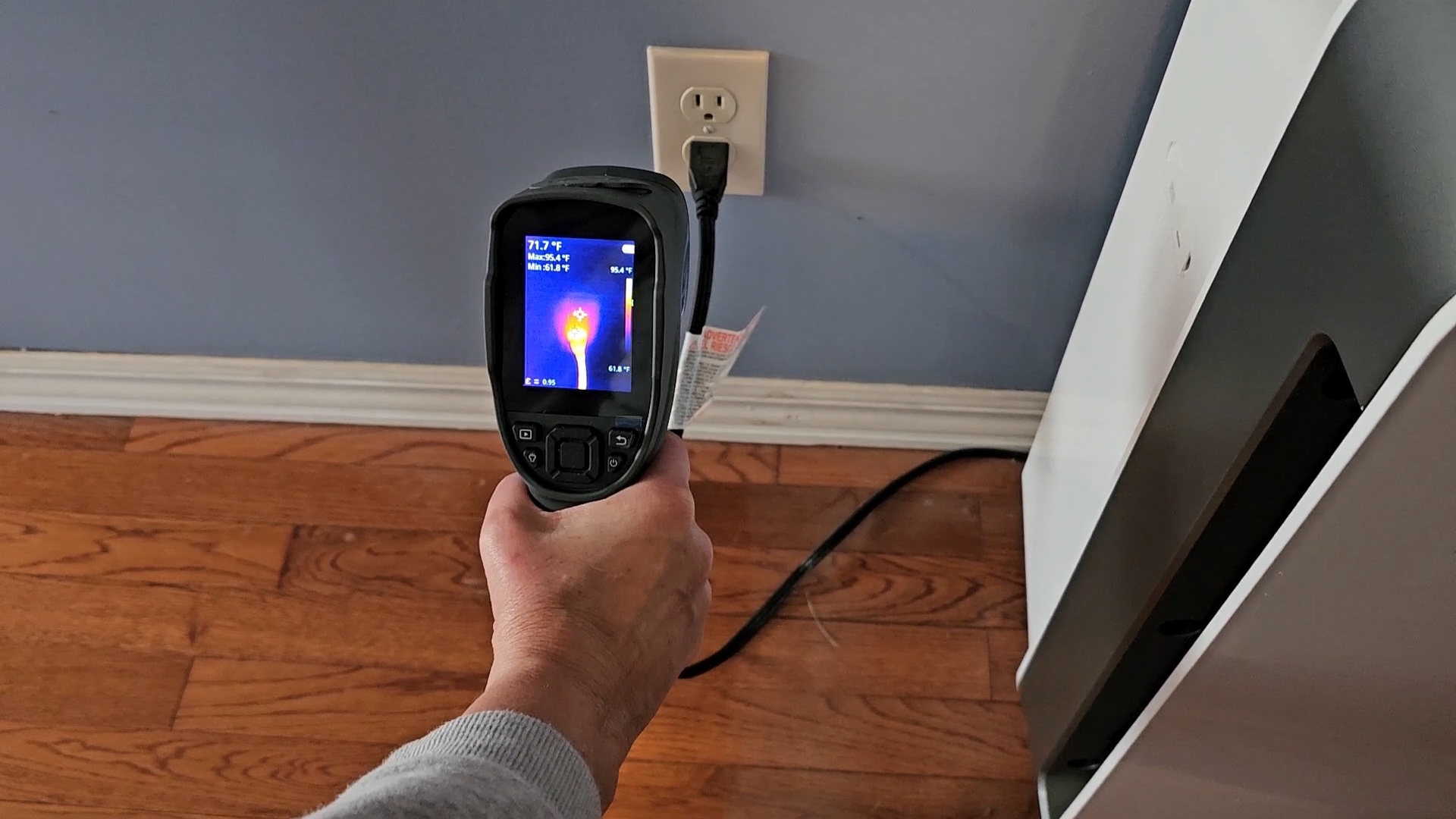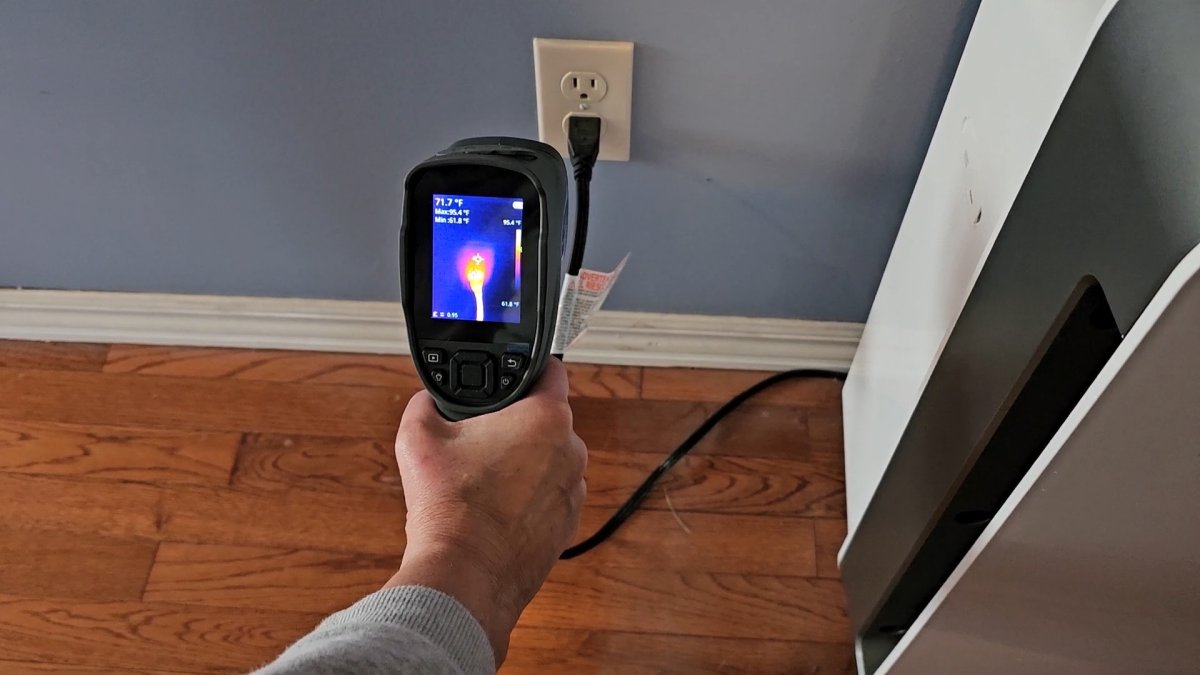

We may earn revenue from the products available on this page and participate in affiliate programs. Learn More ›
Thermal cameras are vital diagnostic tools for HVAC technicians and mechanics, who use them to identify problems by detecting heat signatures. But they’re also beneficial for homeowners or DIYers who want to locate insulation gaps, troubleshoot electrical issues, or pinpoint leaks and moisture problems.
We researched more than 20 best-selling models and chose the TopDon TC005 Thermal Camera for hands-on testing, paying special attention to how easy it was to use the camera and understand its detected temperature ranges. We found that the TC005 provides high resolution, is easy to use, and provides images that can be transferred to a PC for closer inspection.
However, the TC005 is just one of many reputable thermal cameras on the market, so we’ve highlighted a few other models worth considering. Keep reading to learn more about how to choose a thermal camera and discover how the TC005 became the top pick in our lineup of the best thermal cameras.
Best Overall
Photo: AmazonWhat We Like
- Good build quality
- Portable and convenient
- Intuitive controls and operation
- Versatile imaging modes
- Records heat data on each image
- Images can be transferred to computer
- Affordable price point
What We Don’t Like
- Screen is relatively small for on-camera viewing
- Lacks high-end features like multi-spectral imaging
Specs
- Thermal resolution 256 x 192 pixels
- Modes 4
- Runtime 12 hours
- Temperature range -4 to +1022 degrees Fahrenheit (-20 to 550 degrees Celsius)
- Screen size 2.8 inches
The TopDon TC005 impressed us right out of the box. We liked its build quality and non-slip ergonomic design. Weighing just over 1 pound, it has enough heft to feel substantial yet is not cumbersome. It comes with a canvas case with a belt loop and a strap for carrying the camera across the body. The package also includes a 16 GB memory card and a USB cord for charging and transferring images to a tablet or PC.
We liked how intuitive using the TC005 was. It has four imaging modes we could scroll through to find the best visibility depending on what we were looking for. The heat signature was brightest in infrared (IR) mode, but we could also switch to visible light, which was handy if we wanted to take pictures both with and without IR for comparison on a computer later. The other two modes combine infrared and visible light in different degrees.
Taking a photo requires a simple trigger squeeze, and the image is automatically saved to the memory card. Scrolling through the images on the camera display gave us a quick view, but the best way to see them is to upload them to a computer. We downloaded TDView, Topdon’s app for viewing the images, but they can also be opened with other image editing programs, such as Photoshop, Windows Viewer, and Lightroom.
The TC005 provides vital heat signature information by marking each image’s hottest, coldest, and central temperatures with little bullseyes. It also displays the corresponding numerical temperatures in Celsius or Fahrenheit.
The TC005 may lack the sensitivity needed for specialized fields such as industrial engineering, but it’s a solid pick for DIYers, home mechanics, and pros looking to detect drafts, insulation issues, and electrical hotspots.
What our Tester Says: “I was impressed with the TopDon thermal camera’s ability to detect both the highest and lowest temperatures in the images. It makes it possible to pinpoint where heat loss or excessive heat is occurring.” —Glenda Taylor, Product Review tester and writer
Get the TopDon thermal camera at Amazon or Walmart.
More Thermal Cameras Worth Your Money
While we only tested the TopDon TC005, several other heat sensor cameras made our shortlist. The following models offer a range of sensitivity and features. You’ll find smart camera add-on modules, Wi-Fi-capable models, and high-end thermal detectors. One is sure to meet your heat-detection needs.
- Flir One Gen 3 Thermal Camera for iOS Smart Phones, available at Amazon or Flir.
- Flir TG267 Thermal Camera, available at Amazon or Flir.
- Flir C5 Handheld Compact Thermal Camera, available at Amazon or Flir.
- Flir One Pro LT Pro-Grade Thermal Camera, available at Amazon or Flir.
- Flir MR160 IGM Moisture Meter, available at Amazon or Flir.
- F2W Thermal Camera with Wi-Fi, available at Amazon.
- Ancel IR101 Thermal Imaging Camera for Android, available at Amazon or Walmart.
- TopDon Thermal Camera for iPhone, available at Amazon.
- TopDon TC002C Duo Thermal Camera, available at Amazon or Northern Tool + Equipment.
How We Chose and Tested the Best Thermal Cameras
In selecting thermal cameras for our lineup, we researched more than 20, narrowing the list based on features, build quality, and consumer feedback, and then chose the TopDon TC005 for hands-on testing. While Flir makes some of the best thermal cameras around, they can be pricey, and we wanted to test a model that would be well-suited to a wide range of users.
In actual testing, we used the thermal camera in the same ways most DIYers would. We checked around our doors and windows for heat loss. We scanned outlets and monitored plugged-in appliances to see if the cords were overheating. We checked our automobile engine to see if there were any concerning hotspots, and even had a little fun taking thermal photos of our dog.
We paid special attention to the temperature ranges detected by the TC005 and noted how easy it was to use the thermal camera, and also downloaded the app and used it to view our thermal images.
What to Consider When Choosing a Thermal Camera
The best thermal camera for your needs can depend on several factors, including size, temperature range, resolution, image enhancement capabilities, and task-specific accessories, such as wall probes for leak detection. Here are a few things to consider before selecting a thermal camera.
Types of Thermal Cameras
Thermal cameras fall into three main categories based on how they are used. The types are handheld thermal cameras, infrared phone camera attachments, and thermal drones.
Handheld Thermal Cameras
Handheld thermal cameras are commonly used for household inspections and for many industrial applications. This type of heat sensor camera can have a small body the size of a smartphone, or it can be large enough that it necessitates the use of a camera grip for proper focus.
For the majority of thermal camera applications, such as looking inside a home’s walls, floors, or other spaces, a handheld thermal camera is suitable. While these cameras are larger and more expensive than a smartphone attachment, they also may have thermal camera-specific screen resolutions and a wider range of features, including contactless body temperature readings, a built-in laser guide, or a visual light camera.
Smartphone Thermal Camera Attachments
A smartphone thermal camera attachment allows you to use your smartphone to read the heat signatures of infestations or your electrical, HVAC, and plumbing systems. The attachment plugs into the base of your device so that you can simply control the camera through your touchscreen and upload the collected pictures or scans directly into your phone.
This type of device is inexpensive and easy to use, making it a great option for infrequent or DIY home inspections, but it is not recommended for professional use. This is because cheap thermal camera attachments lack the high image quality and precise measuring accessories that handheld thermal cameras normally offer. They may also drain your smartphone battery quickly, ultimately limiting viewing time.
Thermal Drones
Using a thermal drone for a home inspection might seem like overkill, but there are many issues that cannot be detected from inside the house. Unless you are willing to get up on a ladder or another high perch, a thermal drone is a great way to find out if you have any hidden problems.
Possible problems that a thermal drone can help detect include nesting insects, such as termites or other animals, blockages in the drainage system, and areas in the roof or exterior walls where heat is escaping, indicating the need to repair a hole. These devices combine the flight capability of a drone with the functionality of a thermal camera. However, they are usually quite expensive and are better suited for those with a professional roofing or home inspection business. It is also possible to find a thermal camera to attach to an existing drone for drone photography.
Size, Weight, and Grip
The size and weight of a thermal camera are also worth considering if the device is going to be used for any extended period of time. Heavy or large cameras or those with an uncomfortable grip can contribute to or help avoid hand fatigue.
Small thermal camera smartphone attachments are easy to carry, but they don’t have the same kind of stable grip as standalone thermal cameras. Smartphone attachments are great for travel and quick inspections, but they are not suited for long periods of use. Handheld thermal cameras can range in size, but those best suited for comfort typically come with a padded camera grip that is easy and comfortable to hold. Because thermal drones can fly, their size and weight matter less, but the comfort of their handheld controllers determines how long the user can control the drone before hand fatigue sets in.
Temperature Range
When looking for a thermal camera, you will notice that the manufacturer typically states the minimum and maximum temperatures that the device is capable of accurately reading. Smartphone attachments normally have moderate thermal sensitivity from -4 to 248 degrees Fahrenheit, while handheld thermal cameras may extend the temperature range from -13 to 716 degrees Fahrenheit.
Larger temperature ranges allow you to detect problems that can’t be seen with the human eye in HVAC systems, hot water tanks, or vehicles. Thermal drones typically have a similar range to handheld thermal cameras, with the added bonus of flying capabilities. When shopping for a camera, keep in mind the highest and lowest possible temperatures you would normally find during your inspection.
Resolution
The thermal resolution of a thermal camera can help a user hone in on potential issues. The more precise a thermal camera is, the easier it is to pinpoint exactly where the problem lies, potentially saving you from making costly mistakes.
For example, a low-resolution camera may present a broad-spectrum image of a plumbing system that vaguely shows an increase in temperature extending outside the pipe. While this information helps to determine that a hot water leak or insulation gap exists, the reading may not show the exact location of the leak. With a higher-resolution camera, you can identify the flow of water and open a hole just wide enough to stop the leak.
To accurately recognize and diagnose what you are seeing through the thermal camera screen, you need a high thermal resolution. Thermal resolution quality is measured in pixels and can range from as low as the 60 by 60 pixel resolution commonly seen on smartphone attachments to as high as 320 by 240 pixels. A higher resolution may be especially important for professionals looking for a precise thermal imaging device to identify and target repair needs.
Accuracy and Repeatability
Temperature accuracy, which is measured in degrees Celsius or degrees Fahrenheit, is another factor that can help ensure precise readings with a thermal camera. For example, the Occupational Safety and Health Administration suggests that hot water heaters should heat water to a temperature of 140 degrees Fahrenheit to prevent the spread of certain diseases, but the American Academy of Pediatrics recommends a setting of between 120 and 130 degrees Fahrenheit in homes with small children to prevent accidental scalding and burning, and the Consumer Protection Safety Commission has similar recommendations to protect the elderly, so precision is important.
An accurate thermal camera can verify that a hot water heater is performing to the appropriate standard or if it needs to be repaired or replaced. Typical thermal cameras have an accuracy range of plus or minus four degrees Fahrenheit, though there are more accurate thermal imaging cameras.
The accuracy range accounts for several factors that can affect how infrared energy is measured. These can include ambient temperature, camera response, emissivity, transmittance, calibrator temperature accuracy, and atmospheric temperature. The more repeatable a reading is, regardless of these intervening factors, the more accurate a camera will be.
Thermal Image Enhancement
Along with a high-definition thermal resolution, a camera can enhance its thermal image by using overlays of nonthermal video recording. This feature makes visible low-contrast objects even in areas with very wide temperature ranges, allowing you to differentiate between two similar targets.
The result is a detailed thermal image with overlays of sharp corners and edges that give the objects some identifiable structure. This feature can help identify studs in a wall, plastic pipes, and even furniture in a dark room. It is typically used by firefighters to quickly identify their surroundings so that they can take appropriate actions to put out the fire and help anyone nearby.
Visible Light Image Enhancement
Thermal cameras do not typically need visual light to create thermal depictions of an object or objects. However, it is easier to identify possible problems and anomalies in electrical, plumbing, HVAC, or even automotive systems when the structure is visible to the naked eye.
To this end, some thermal cameras have a visual light enhancement feature that illuminates low-light video to better highlight the outline and structure of scanned objects. With this feature, you might also be able to change the visual tone and appearance of the output—almost like choosing a photo filter—to find the best view of the problem.
File Formats and Data Output
Thermal cameras don’t only allow you to view and identify possible issues in real time. They can also be used to take a picture or video, which you can then send to your repair technicians so that they are better informed before showing up to help fix it.
Home inspectors and many other industry professionals who use thermal cameras regularly need to be able to take photos, store them, and even send them wirelessly to others. Thermal cameras may have BMP or JPEG file formats. BMPs can be difficult to convert to a readable form, while JPEGs can be read by most devices.
Data can be saved on the camera or it can be saved on a computer or another device. This usually requires a USB-C cord, but some cameras can connect to Wi-Fi. A thermal camera snap on attachment can send data directly to the connected smartphone, where it can be read much like on a computer.
Companion Tools
Thermal cameras can be used for many different purposes and typically do well as standalone tools. However, many thermal cameras come with accessories designed to help detect specific problems, such as using moisture meter probing bars to better find plumbing leaks. Another frequent companion tool is a voltage detector that can detect the presence of electrical voltage with vibration, lights, or sound alarms.
Depending on the purpose, a variety of useful companion tools including clamp meters, moisture pens, voltage detectors, moisture detectors, and even thermoprobe connectors that can infrared measurements through narrow gaps may augment the usefulness of the camera.
Tips for Using a Thermal Camera
Though most thermal cameras are pretty straightforward, there are a few things to keep in mind in order to ensure accurate temperature readings. One of the most important points is to steady the aim of the camera and ensure you have the correct resolution and optics for the type of temperature measurement required.
You should also check that your field of view is suitable for the type of measurement you are taking. For example, if you are closely inspecting your home, a wider field of view on your thermal camera may be more effective. Alternatively, when scanning things at a distance, a narrow view may be ideal. Here are a few more tips to consider before using a thermal camera:
- Ensure you understand the colors produced on a thermal camera. Standard colors are red, orange, and yellow for heat and blue and green for cooler areas.
- Adjust the focus and field of view on your camera before and during readings to ensure clarity and accuracy.
- If your thermal camera runs on battery power, make sure to carry a charger or extra battery with you while taking measurements.
FAQs
After learning about the features of thermal cameras, you may have some lingering questions. The answers below may help you decide which kind of thermal camera is right for your purposes.
While the terms are often used interchangeably, the main difference between an infrared camera, like an outdoor security camera, and a dedicated thermal camera is that infrared cameras use short wavelength infrared light, while thermal cameras tend to use medium or long wavelengths of infrared energy. Thermal cameras do not pick up reflected light, but they do pick up directly emitted infrared heat. This means that the image is not distorted by lights, smoke, haze, dust, or any other particulates in the air.
Thermal cameras can be used in residential, commercial, and industrial settings as well as in emergency situations and for security reasons. The most common uses are to troubleshoot technical issues within residential buildings, assess mechanical problems, and detect high heat.
Most objects give off infrared energy that is known as a heat signature. A thermal imager detects and measures the infrared energy and converts the data into an electronic image, which displays the measured surface temperature of the object or objects.
Accuracy varies among individual products, but on average, a thermal camera has an accuracy of plus or minus 4 degrees Fahrenheit. This accuracy can fluctuate when users are in extreme high or low temperatures.
The size, weight, accuracy, resolution, and other features can help you decide on a thermal imaging camera. If you plan on using the tool frequently, consider a model with a long-lasting rechargeable battery. For more occasional or less precise use, there are smartphone attachments that may suit your needs.
Most thermal imaging models are not capable of taking thermal readings through concrete, and other hard surfaces, as they are thick enough to block infrared radiation. They can read a heat signature on a wall caused by something on the other side, such as a heat pipe or hot water leak, but they cannot “see” all the way through a wall to the outside.
Daylight and other light sources do not have an effect on infrared radiation, so unlike night vision cameras, thermal cameras can work just as well in daylight conditions as they do in total darkness. This makes them a great option for anyone looking for a good security camera for the home or office.
Meet the Tester
Glenda Taylor is a contractor, product tester, and writer focusing primarily on construction, DIY tools, and home appliances.
Additional research provided by Timothy Dale.
